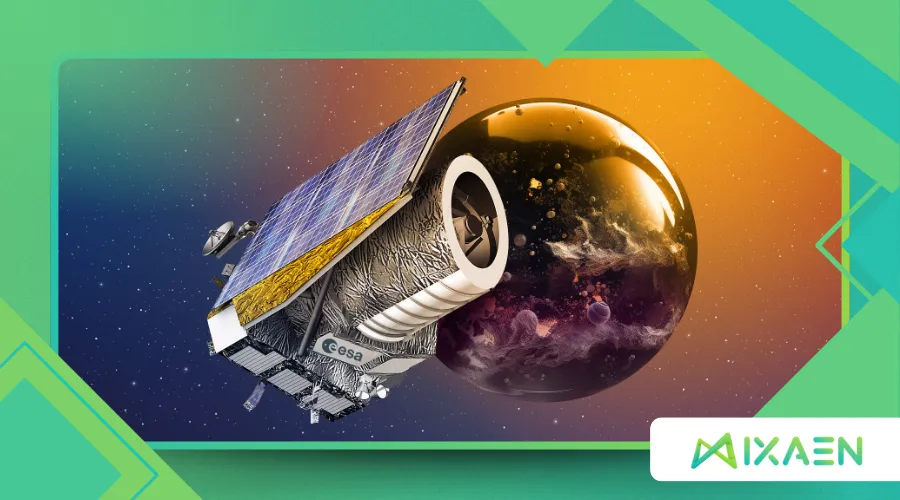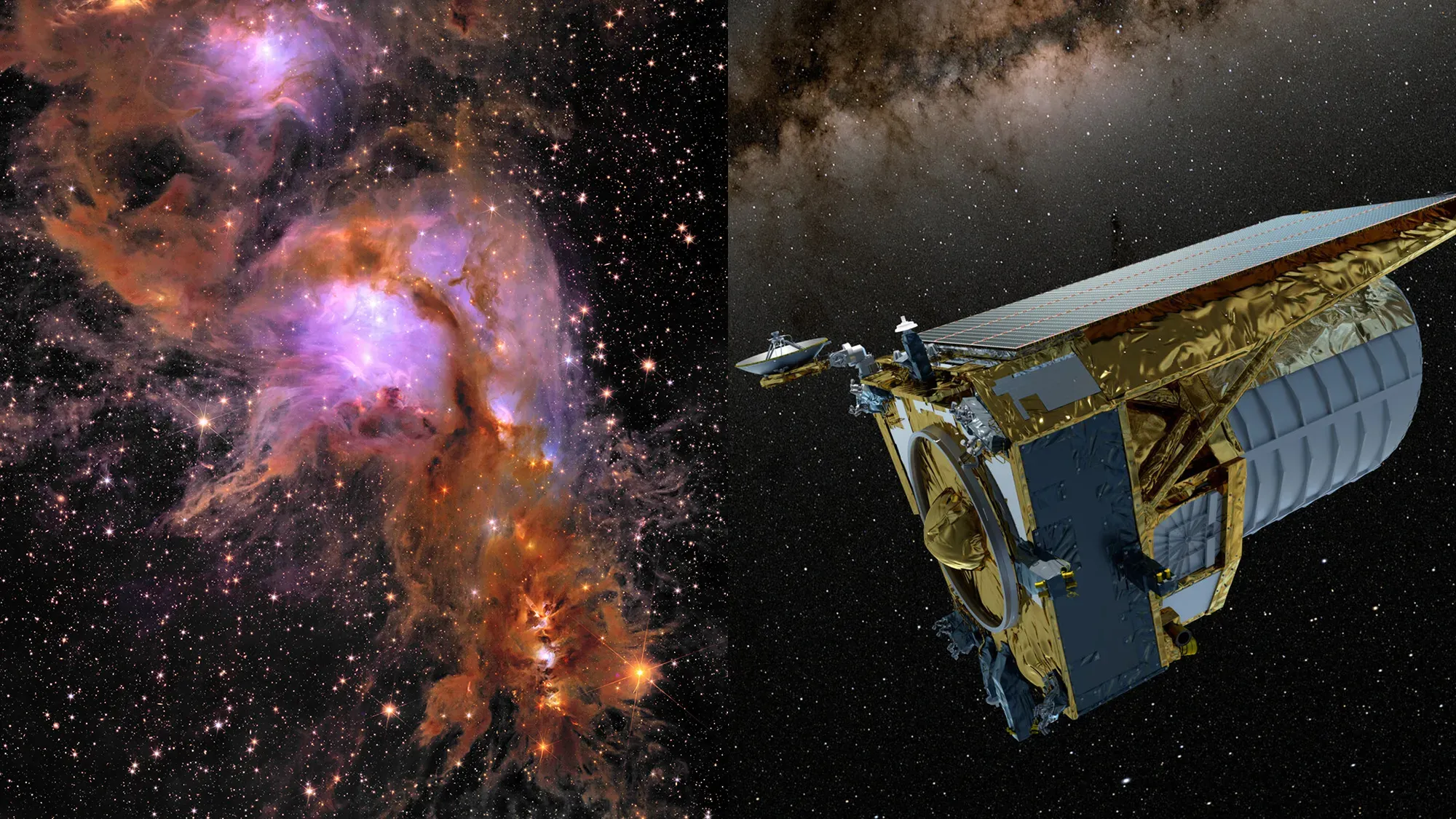Euclid Mission: Discover How the Satellite Will Map the Cosmos in 3D

The Euclid Mission, launched by the European Space Agency (ESA) in July 2023, stands as a beacon of cosmic exploration, poised to unravel the universe’s deepest mysteries.
Anúncios
This ambitious endeavor aims to create the most comprehensive 3D map of the cosmos ever attempted, peering 10 billion light-years into the past to probe the enigmatic forces of dark matter and dark energy.
Unlike any telescope before it, Euclid combines razor-sharp imaging with a wide field of view, capturing galaxies in unprecedented detail across a third of the sky.
This article delves into how this revolutionary satellite will redefine our understanding of the universe, blending cutting-edge technology with bold scientific inquiry.
Why should we care about mapping the cosmos in three dimensions?
The answer lies in the secrets it holds about our universe’s past, present, and future.
As we explore the cosmos, missions like Euclid not only enhance our knowledge but also inspire future generations to pursue careers in science and engineering.
The quest for understanding the universe is a collective human endeavor that transcends borders and cultures.
A Cosmic Cartographer’s Vision
Imagine a cartographer charting an uncharted ocean, not with ink and parchment, but with light from distant galaxies.
That’s the essence of the Euclid Mission.
Stationed at the Sun-Earth Lagrange Point 2, 930,000 miles from Earth, this satellite is designed to observe billions of galaxies with unparalleled precision.
Its goal? To construct a three-dimensional atlas that tracks the universe’s expansion and the clustering of galaxies over cosmic time.
By measuring the shapes, distances, and motions of these celestial bodies, Euclid will reveal how gravity, dark matter, and dark energy have sculpted the universe’s large-scale structure.
The mission’s scope is staggering.
Over six years, Euclid will survey more than a third of the sky, covering 15,000 square degrees—equivalent to 500 times the area of the full moon.
This vast canvas, captured in visible and near-infrared light, allows scientists to study galaxies as far back as 10 billion years ago, when the universe was just a fraction of its current age.
Unlike ground-based telescopes, constrained by atmospheric distortion, Euclid’s vantage point in space ensures crystal-clear images, enabling measurements of galaxy distortions with an accuracy of 1/100,000, a feat likened to measuring the width of a human hair from a mile away.
The precision of Euclid’s observations will not only enhance our understanding of cosmic structures but also improve our models of the universe’s evolution.
As we map the cosmos, we gain insights that could challenge existing theories and lead to groundbreaking discoveries.
Decoding the Dark Universe
Dark matter and dark energy, which together comprise about 95% of the universe, remain among science’s greatest enigmas.
The Euclid Mission tackles these mysteries head-on by employing two primary techniques: weak gravitational lensing and baryonic acoustic oscillations.
Weak lensing measures how the light from distant galaxies is subtly bent by the gravitational fields of intervening dark matter, revealing its distribution.
Baryonic acoustic oscillations, on the other hand, analyze the clustering patterns of galaxies, offering clues about the universe’s expansion driven by dark energy.
A standout feature of Euclid is its ability to capture both high-resolution images and spectroscopic data simultaneously.
Its Visible Instrument (VIS), a 600-megapixel camera, records galaxy shapes with exquisite detail, while the Near-Infrared Spectrometer and Photometer (NISP) measures their redshifts to determine distances.
This dual approach is like a cosmic GPS, plotting galaxies in three dimensions—two spatial coordinates and a third dimension of time, inferred from redshift.
In its first data release on March 19, 2025, Euclid cataloged 26 million galaxies, including 380,000 with precise shape measurements, showcasing its capacity to handle vast datasets with precision.
The data gathered by Euclid will be crucial for understanding the underlying physics of dark matter and dark energy, potentially leading to revolutionary insights in cosmology.
As researchers analyze this information, we may uncover clues that reshape our understanding of the universe’s fundamental forces.

The Technology Behind the Map
Euclid’s technological prowess is a testament to international collaboration.
Built by Thales Alenia Space and Airbus Defence and Space, with NASA contributing detectors for the NISP instrument, the satellite is a marvel of engineering.
Its 1.2-meter Korsch-type telescope captures light with a field of view 0.7 by 0.7 degrees—larger than the full moon.
This allows Euclid to image 50,000 galaxies in a single pointing, a scale unmatched by predecessors like the Hubble Space Telescope, which took 25 years to cover a fraction of Euclid’s daily imaging capacity.
The satellite’s data processing is equally impressive.
Euclid generates petabytes of data, transmitted at 55 megabits per second to the Cebreros ground station in Spain.
Nine Euclid Science Data Centers, including one in Edinburgh, process this data round-the-clock, transforming raw images into scientific insights.
The Euclid Consortium, comprising over 2,000 scientists from 15 countries, ensures that every pixel is scrutinized, turning observations into a cohesive 3D model of the cosmos.
+ The Future of Space Exploration: The Role of SpaceX’s Starship
Table 1: Euclid Mission Instruments
| Instrument | Function | Key Capability | Contribution |
|---|---|---|---|
| VIS (Visible Instrument) | Captures high-resolution images | 600-megapixel camera, 0.7° x 0.7° field of view | Measures galaxy shapes for weak lensing |
| NISP (Near-Infrared Spectrometer and Photometer) | Measures redshift and photometry | Near-infrared imaging and spectroscopy | Determines galaxy distances and masses |
The collaboration behind Euclid exemplifies how global partnerships can drive scientific progress and technological innovation.
As countries unite in pursuit of knowledge, we expand our capabilities and enhance our understanding of the universe.
Why 3D Matters: A New Perspective
Mapping the universe in 3D isn’t just a technical flex—it’s a paradigm shift.
Consider an analogy: a 2D map of a city shows streets and buildings, but a 3D model reveals skyscrapers’ heights, tunnels’ depths, and the city’s evolution over time.
Similarly, Euclid’s 3D map will show not just where galaxies are but how they’ve moved and clustered over billions of years, offering a dynamic view of cosmic evolution.
This approach allows scientists to trace the universe’s expansion history with percent-level accuracy, potentially pinpointing whether dark energy’s influence has varied over time.
For example, imagine a galaxy cluster 6 billion light-years away, like J041110.98-481939.3, observed in Euclid’s Deep Field South.
By analyzing its gravitational lensing, scientists can infer the presence of dark matter, which warps spacetime like an invisible lens.
Another example: the discovery of a dwarf satellite galaxy around NGC 6744, revealed in Euclid’s Early Release Observations in May 2024, highlights how the mission uncovers hidden cosmic structures, enriching our understanding of galaxy formation.
The ability to visualize the universe in three dimensions opens up new avenues for research and discovery, allowing scientists to formulate hypotheses and test theories in ways previously unimaginable.
As we delve deeper into the cosmos, the insights gained from these 3D maps will inform our understanding of fundamental questions about existence.
The Scientific Stakes
The Euclid Mission’s implications are profound.
Dark energy, discovered in the 1990s through studies of supernovae, drives the universe’s accelerating expansion, but its nature—whether a cosmological constant or a dynamic field—remains unclear.
Euclid’s precise measurements could rule out competing theories, refining our models of cosmology.
Similarly, dark matter’s clumping patterns, revealed through lensing, could confirm whether it consists of weakly interacting particles or something more exotic.
A striking statistic underscores Euclid’s ambition: it aims to observe 1.5 billion galaxies with sufficient precision to study their distortions, a dataset 100 times larger than previous surveys like the Dark Energy Survey.
This scale enables unprecedented statistical power, reducing uncertainties in cosmological parameters.
As Professor Carole Mundell, ESA’s Director of Science, noted, “Euclid is a dark detective, unraveling the 95% of the universe we don’t yet understand.”
++ The Greatest Space Probe Records: Speed, Distance, and Incredible Achievements
Table 2: Euclid Mission Milestones
| Date | Milestone | Details |
|---|---|---|
| July 1, 2023 | Launch | Launched on SpaceX Falcon 9 from Cape Canaveral |
| February 14, 2024 | Nominal Survey Begin | Started routine science observations |
| March 19, 2025 | Quick Euclid Data Release 1 (Q1) | Cataloged 26 million galaxies, including 380,000 with shape measurements |
| October 2026 | First Year Cosmology Data Release | Will cover 53 square degrees, including deep fields |
The stakes of the Euclid Mission extend beyond theoretical implications; they hold the potential to reshape our understanding of the universe and our place within it.
As we gather more data, we may find answers to questions that have puzzled humanity for centuries.

Challenges and Triumphs
Euclid’s journey hasn’t been without hurdles.
Early test images in 2023 revealed stray sunlight interfering with the VIS instrument, forcing a redesign of the survey strategy.
Scientists and engineers collaborated to adjust the satellite’s orientation, ensuring clean data.
This adaptability highlights the mission’s resilience, a quality that will be tested as it processes petabytes of data over its six-year lifespan.
The complexity of handling such volumes, coupled with the need for 35 milli-arcsecond pointing accuracy, underscores the mission’s technical sophistication.
Yet, the triumphs are already evident.
The March 2025 data release included three deep fields, showcasing galaxy clusters and gravitational lenses with unprecedented clarity.
These early results, covering just 1% of the planned survey, hint at the transformative discoveries awaiting as Euclid progresses.
The mission’s ability to detect rare phenomena, like the Einstein ring discovered in September 2023, demonstrates its potential to uncover cosmic surprises.
The challenges faced by the Euclid Mission serve as a reminder of the complexities involved in space exploration.
With each obstacle overcome, we gain valuable insights that enhance our understanding of the universe.
For more information on the mission, visit the official ESA page here.
Engaging the Future
What will Euclid’s 3D map reveal about our place in the cosmos?
This question drives the mission’s scientific heart.
By 2026, when the first year’s cosmology data is released, we may have clearer answers about dark energy’s role in cosmic acceleration.
The mission’s synergy with NASA’s upcoming Nancy Grace Roman Space Telescope, set to launch by May 2027, promises complementary insights, with Roman offering higher-resolution images of a smaller sky patch.
Together, they could redefine cosmology, much like explorers charting new continents reshaped our understanding of Earth.
The Euclid Mission isn’t just a scientific endeavor; it’s a testament to human curiosity and collaboration.
From the engineers who built its instruments to the scientists analyzing its data, thousands of minds across 15 countries are working to decode the universe’s secrets.
As Euclid continues its cosmic survey, it invites us all to ponder our origins and the forces shaping the vast, mysterious cosmos we call home.
By engaging with the findings of the Euclid Mission, we can foster a deeper appreciation for our universe and inspire future generations to explore the unknown.
